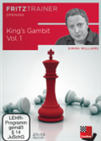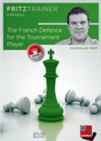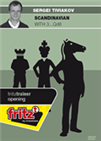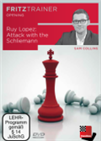A review

I never played 1...e5; as Black, I toyed with the idea of playing the Petroff (a.k.a. Russian) Defense 1.e4 e5 2.Nf3 Nf6 because for a certain period I was playing 1.e4, as White, and a friend of mine, with whom I played blitz often, had good result against me using the Russian Defense.
However, a good way to neutralize it, and play sharply, was through the King's Gambit, which I employed against my friend, to avoid his Russian defence.
1.e4 e5 2.f4
 This DVD concentrates on the King's Gambit accepted with 3.Bc4. Williams has included a lot of novelties and interesting attacking variations that should wet the lips of any attacking player, looking for an interesting way of meeting 1...e5!
This DVD concentrates on the King's Gambit accepted with 3.Bc4. Williams has included a lot of novelties and interesting attacking variations that should wet the lips of any attacking player, looking for an interesting way of meeting 1...e5!
 This French Defence DVD is a complete attacking opening repertoire for black after 1.e4 e6. GM Nick Pert has played the French defence his whole life and provides all his la test and most up to date analysis crammed into 1 DVD.
This French Defence DVD is a complete attacking opening repertoire for black after 1.e4 e6. GM Nick Pert has played the French defence his whole life and provides all his la test and most up to date analysis crammed into 1 DVD. For those who want to know about this sharp opening, GM Williams made 2 DVDs for Chessbase, in his typical pragmatic style, devoted to give us all the most sharp-attacking idea!
As Black I tried to copy my friend, and use the Russian defence in blitz games online, but the results were not so good, the main reason was that some lines were quite long and theoretical, and unfortunately I didn't have enough time to prepare (often to build the confidence to play an opening in tournament takes 6 months or more).
So I opted for the French taught by an amazing teacher: GM Pert.
Then tired of the French, in which I felt claustrophobic, I passed to the Scandinavian, as taught by GM Tiviakov, but also with such opening I felt tight and passive, it was a mix of French and Caro-Kann. It was clearly a solid opening, but I felt the need for something more active to contrast White's 1.e4.
Now I'm changing again, because I feel the need to discover if this repertoire proposed by Collins fits my style as Black player against 1.e4
 The Scandinavian with 3...Qd6 could just as well be called “The Tiviakov System”. On this DVD GM Sergei Tiviakov shows you everything you need to know to be able to play 3...Qd6 yourself at once.
The Scandinavian with 3...Qd6 could just as well be called “The Tiviakov System”. On this DVD GM Sergei Tiviakov shows you everything you need to know to be able to play 3...Qd6 yourself at once.Collins has made few DVDs on using 1...e5 against the Ruy Lopez. One of the latest DVDs was dedicated to placing the Bf8 on g7, after the moves: 1.e4 e5 2.Nf3 Nc6 3.Bb5 g6
In the fight for playable, unbalanced positions after 1.e4 e5, many top players (including World Champion Magnus Carlsen) turned to 3…g6 against the Ruy Lopez (2.Nf3 Nc6 3.Bb5). Black aims for a kingside fianchetto combined, depending on White’s reaction, with …Nf6 or a quick …f5. In this DVD, Sam Collins explains the key ideas of 3…g6 and provides a complete repertoire for Black, suitable for regular use.
Such system has also been used by Carlsen, always in the attempt to unbalance his opponenents' preparation, like in the following game:
Collins also made a DVD on the Jaenisch gambit, to attack the Ruy Lopez.
 In this DVD Sam Collins provides a complete and detailed repertoire for Black. Numerous novelties and improvements are suggested, with the conclusion that White has no clear route to an opening advantage.
In this DVD Sam Collins provides a complete and detailed repertoire for Black. Numerous novelties and improvements are suggested, with the conclusion that White has no clear route to an opening advantage.Which happens after the moves: 1.e4 e5 2.Nf3 Nc6 3.Bb5 f5
I'm introducing the many works made by Collins to show the extreme degree of knowledge, and preparation, this professional player has, and the good opportunity we have to learn from such great teacher!
Now Collins is giving a complete repertoire for Black based on the move Bc5.
Collins in the introductory video begins to explain the advantages and disadvantages of the bishop on c5. Clearly the advantages are the pressure on f2 — because if White makes a mistake, he can lose the pawn — and also control over the center, plus greater activity compared to a bishop developed to e7 or g7.

The negative sides are interesting too. For example White can try to render passive the bishop, with the pawn chain: c3-d4, which can lead to violent fights for center control!

Another consequence of Bc5, followed by d7-d6 (closing the dark squares bishop on the queenside, compared to when such bishop is developed in e7) is that White can pin the Nf6 with Bg5.

The liberating maneuver, from such pinning, can also be source of risk, because in some cases White can sacrifice on g5, as in the following example played by one of the greatest women in chess history:

Sofia Polgar | Photo: Jonathan Levitt CC-BY-SA-3.0 via Wikimedia Commons
However in the DVD Collins teaches us how to neutralize this dangerous sacrifice, making the DVD worth it for this bit of research alone!
Let's review the contents of the DVD. There are 34 videos covering most of White's options, and telling us how big our repertoire will be. This could be frightening, but the point is that some themes which happen in the Ruy Lopez, can be used in the Italian game or in the King's gambit, hence playing this repertoire will open our minds to use an idea we learned in one opening for another opening!
Spanish — 1.e4 e5 2.Nf3 Nc6 3.Bb5 Bc5
To the Spanish has been dedicated the bulk of the DVD, with 16 videos. Logically the Spanish is a very theoretical opening, with a long history, played by all world champions, and historically by all major players. A true formative opening for each player.
The first video clip deals lightly with some possible deviations on the 4th move, and the main 4.Nxe5.
Before going on with the review, I'd like to share how we need to operate, and do our own homework, if we are really going to play this opening, as I will surely do! Before 4.Nxe5, Collins shows a deviation: 4.Bxc6 (the Spanish exchange) 4...dxc6; 5.0-0 f6 and gives his evaluation: "Black is comfortable in this position."
Once I have a line, I use my Megabase to locate games played in that line.
No GM ever played it, but I found an interesting game, where White is rated around 1500, and Black over 2000, and Black lost badly! This teaches us to avoid the assumption that just because Collins said the position is comfortable, it will be a very easy win.
Once I find a game where Black lost badly, I also try to identify the reasons, so I'll be ready in my tournament games. One way to do it, using Chessbase 14, is to go under the Training Tab, and push the button "Play out against Fritz" in this way one can practice the opening, and gain some experience before a tournament. It will open a browser window, and bring to the Chessbase Online account, where one can follow the latest games played in major tournaments, as well in this case play the position against one of the strongest engines in the world.

Then the DVD continues with the Italian Game — 1.e4 e5 2.Nf3 Nc6 3.Bc4 Bc5, with three videos.
Believe it or not, this is another opening, which like the Spanish, should be given a big space, because it is clearly the theoretical battlefield of many champions also nowadays, as proven by one of the latest works published on it from none other than Wesley So!
Now I'd like to share my experience with the DVD. First of all I had a little more than one month before the next tournaments, and I wanted to learn this new repertoire, but how to become confident in it?
I used the main lines given as "content" of the DVD on my Megabase 2017, for each line I watched at least 20 games, trying to absorb the main ideas for both sides. When the games were not good quality, I would play the line against an engine, as mentioned above.
This would help me to see what were the main tactical tricks I could fall into, and it was a slaughterhouse! The computer is definitely the most boring and annoying opponent one can find! It always wins! However, one month wasn't enough to build confidence, and I had to give it more time, now we are more than four months away from the first contact, and I'm still not ready. One must acknowledge one's own limitations, maybe it will take me a year, before being able to use it with some form of competence.
Another line which was quite interesting, especially if I'd use this new repertoire for Blitz is the following: 1.e4 e5 2.Nf3 Nc6 3.Bb5 Bc5 4.Nxe5 Nxe5 5.d4
Believe it or not, when I was watching Collins introductory video, these were the first moves which crossed my mind when I thought how White would play this opening.
Also in this case it is important we do our homework. When I looked for games using this line, my attention was captured by a draw played in the ICCF.
The ICCF is the correspondence chess federation, and they allow the use of engines in their games, making the humans quite stronger than any possible human champion. They also have three days per move, which means they have the chance to go quite deep in their analysis, hence the game quality is good, and worth watching:
As I wrote before, the Spanish is covered with a total of 16 videos. Three videos cover the Italian game. Two videos are dedicated to the Four Knights. The Scotch, King's Gambit, Vienna, Centre game, and Evans Gambit have a video each. The DVD ends with ten videos of testing positions.
I'd like to linger a little on the King's Gambit: 1.e4 e5 2.f4
The King's Gambit is a very dangerous opening, which cannot be under-estimated, because from my search in Megabase 2017 it is well alive at all levels from 1700 to 2500 rated players — everyone plays the King's gambit once in a while! Therefore the need to spend some time studying the games and playing some games. Collins gave a good selection of games on the king's gambit in the model database. Needless to say I watched them all, and commented some of them.
As noted above, GM Williams released a pair of DVDs on the King's Gambit, and yes, in my opinion if one wants to play the open games as black, he or she needs to acquire those video series, and study them, because what is important are the ideas behind, and maneuvers we could miss in a tournament game. If we don't cover all the bases in our preparation (which means to learn white's ideas and plans!), we are going to suffer some tough losses.
On the Scotch: 1.e4 e5 2.Nf3 Nc6 3.d4 exd4 4.Nxd4 Bc5 5.Nb3 Bb6 Nc3 Nf6
This is not what Collins recommends, I will not say what he taught on the DVD, because I don't want to spoil the surprise for the white players reading this review!
I found it interesting that Collins analyzed the latest trends in the Scotch, and gave us a safe path to navigate such dangerous opening!
By the way, for what regards the Scotch gambit: 1.e4 e5 2.Nf3 Nc6 3.d4 exd4 4.Bc4 Bc5 5.0-0 d6
it is discussed under a different move order in the video: "Italian Various 4th moves," this is the move order given: 1.e4 e5 2.Nf3 Nc6 3.Bc4 Bc5 4.d4 exd4 5.0-0 d6
Collins deals also with the Centre Game: 1.e4 e5 2.d4 exd4
This is one of the openings where obviously we cannot use the Bc5 move. But it is also interesting, because it can lead through transpositions into other openings. Once more my mantra is: "Do your homework" because the author of this DVD — though very professional, and clearly good in his field — cannot cover everything.
In fact, while I was in a big tournament, a friend introduced me to a master level player who wrote a book on the Centre Game as repertoire for White, which would be good to play it against players up to or rated around 2000.
I'd like now to show you a game, because beauty and top chess should always be on our to-watch list!
This game is mentioned by Collins in the video, and in fact is pretty amazing! Collins adds that in this case doesn't matter the opening, because in his opinion to play against Morozevich is impossible, independent of the opening!
The DVD has two databases, one of "model games", with 1604 games, and the other is made by the analysis of the lines shown in the videos, which form the theoretical part, for a total of 23 game-lines. This second database is quite important, because we can use it as reference. After we play a game, we can return to this database, and update it with the line actually played in our game. In this way, after a while, we will have a reference to use in preparation of a tournament, which will be easily linked to our memories on the board.
By the way, a DVD or a book, often written by a titled player, can miss some continuations that are important for club players. Does this make the DVD or book bad? Absolutely not, because the truth is (at the risk of repeating myself): we need to do our own homework!
All this material will not magically enter our heads if we don't make any effort. A very important effort could be to find sidelines which were not treated, and prepare them for our tournament games.
For example the line: 1.e4 e5 2.Bc4 Bc5 3.Qh5 is not treated by Collins in the videos.
However, there are three games which can give an indication of how Collins would play against such idea, in the model games Database (the one with 1604 games!). But all three transpose into an Italian game. They are played with the following move order:
1.e4 e5 2.Bc4 Nc6
So what I did was once more to open my Megabase. Many don't understand the importance of Chessbase 14 and a Megabase with 7-8 million games, but in this new century in order to prepare for a tournament, we need to have tools which speed up and improve our training.
I Placed in the filter the above position, and out of 7 million games the program found over 220 played with such line:
The first game was played by Gioacchino Greco, an Italian player of the 1600s, this is the game:
Quickly I went over these 200 games, to have an idea of what White plays and why. This is what I call doing the homework, because Mr. Collins can help you only up to a certain extent, then we need to cover all our bases, before losing a game, because we didn't study what Collins didn't cover!
And why did I say we need to watch quickly all games? Because some are not worth (full of blunders from both sides), but some, like those played between 2100-2300 rated players can relate to our tournament experience, and the level of opposition we face, like the following game:
To think that a line with Qh5 is played just by amateurs, or players under master level is a mistake, as in the following game played by strong Russian GMs
In general what I'm trying to convey is that once I've seen all the videos, but also while watching them, I jot down all the crazy ideas, lines, and moves Collins didn't explain, or treat, and see if there are games played with them, because my opponent could play that move or idea during a tournament game, and I don't want that kind of surprise.
Now that we are coming toward the end of the review, I'd like to share one small criticism, because as reviewer I must be impartial, Collins says "ahm... ahm... ahm..." too many times. Obviously this doesn't change the good quality of the content provided, but surely Collins can improve the presentation removing it before each phrase he says.
In conclusion
I felt Collins is a good teacher because I realized he researched what the current trends of many openings are, and gave us a repertoire to neutralize those ideas. Many of our opponents do pay attention and copy their chess champion's opening repertoire. It would be naive to think we can neutralize hours of research over the board, hence the need of an experienced titled player like Collins who tell us what we are going to face, and how to deal with it! However, it must be also made clear, this is a high maintenance repertoire. One must keep it updated with the latest theoretical findings. This means that every Monday one needs to download the latest games played in the major tournaments around the world, and look for each line if there were novelties or new ideas.
That said, good luck, and have fun playing against 1.e4 with Bc5!
Links

























